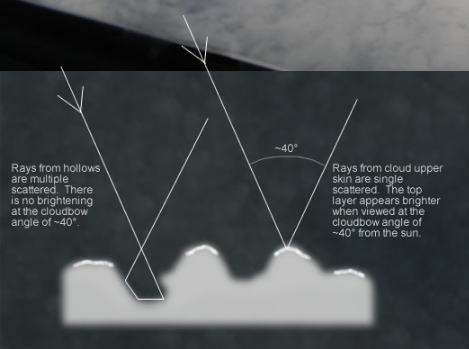Below the Horizon
Below the Horizon: Exploring the Enigmatic Cloud Contrast Bow
As we gaze out of an aircraft window, our eyes are often drawn to the mesmerizing spectacle of the sky. Amidst the ever-changing tapestry of clouds, a discerning observer might notice a subtle and intriguing phenomenon known as the cloud contrast bow. This enigmatic feature, rarely captured on camera, manifests as patches of sharply defined cloud detail amidst the surrounding cloud cover.
The cloud contrast bow is a variant of the cloudbow or fogbow, appearing as an arc with a radius of approximately 40 degrees centered on the antisolar point. To catch a glimpse of this elusive spectacle, one must pay attention to the interplay between cloud movement and the zones of higher contrast. As the aircraft drifts, cloud features are gradually shifted across these areas, enhancing the visibility of the cloud contrast bow to the naked eye.
Cloudbows and fogbows arise from single scattering by minuscule cloud droplets. In the sunlit outer and uppermost layer of the cloud, single scattering gives rise to a broad and essentially colorless bow. However, at the angles corresponding to the bow, there is a subtle brightening of the cloud surface. This effect occurs because sunlight interacts with droplets deeper within the cloud, leading to multiple scatterings in various directions and preventing any particular angle from exhibiting noticeable brightening.
The increased contrast observed at the positions of the fogbow can be attributed to the structured nature of the upper cloud envelope. In parts where the cloud cover is in partial shadow, less direct sunlight reaches these regions, resulting in more multiple scattering and a loss of bow directionality. Consequently, the brightness disparity between the top surface and the hollows of the cloud is heightened, rendering the intricate details of the cloud more easily discernible.
To fully grasp the nature of the cloud contrast bow, it is essential to understand the underlying physics. The interaction between sunlight and cloud droplets plays a crucial role in shaping this atmospheric phenomenon. By comprehending the intricate interplay between scattering, multiple scattering, and the positioning of the observer, we can unlock the secrets behind the captivating cloud contrast bow.
While the cloud contrast bow may be elusive and challenging to capture on camera, it serves as a reminder of the awe-inspiring beauty that permeates our atmosphere. Its subtle presence beneath the horizon beckons us to contemplate the complexities of light scattering and the ever-changing dynamics of our atmosphere. By appreciating these fleeting moments of natural wonder, we deepen our connection to the world around us.
In our quest to explore the mysteries of atmospheric optics, the cloud contrast bow stands as a testament to the boundless wonders that await our discovery. As we peer out of aircraft windows or gaze at the sky from below, let us remain attuned to the subtle nuances that unfold before our eyes. For within the vast expanse of the heavens, hidden treasures like the cloud contrast bow await those with a keen eye and an unwavering curiosity. So, next time you find yourself soaring through the skies or simply marveling at nature's splendor, take a moment to look "below the horizon" and witness the captivating dance of light and clouds in all its glory.

Cloud Contrast Bow seen by Mario Freitas (site) of Universidade Tecnol�gica Federal do Paran�
Curitiba, Brazil. ©Mario Freitas, shown with permission.
Curving across the clouds below the aircraft is a barely perceivable feature. There are patches (arrowed) where the cloud detail is strangely more sharply defined than elsewhere. This is a rarely imaged "cloud contrast bow".
The bow is a subtle form of cloudbow or fogbow - look for it as an arc of ~40� radius centered on the antisolar point. Contrast bows are hard to spot and are most easily seen by eye as the aircraft movement drifts cloud features across the zones of higher contrast.
Cloudbows/fogbows arise from single scattering by small cloud droplets. Here single scattering in the sunlit outer and uppermost skin of the cloud is forming a broad and essentially colourless bow and at the bow angles there is therefore a very slight brightening of the cloud surface. Droplets deeper in the cloud also scatter sunlight but rays interact with several droplets and are scattered at all angles leading externally to no brightening at any particular angle occurs.
Why is contrast increased at the fogbow positions? When the upper cloud envelope is structured, parts are in partial shadow. These parts are not brightened in the bow positions because they are in less direct sunlight and their light has undergone more multiple scattering thus losing the bow directionality. The net effect is that the brightness difference between the top surface and the hollows is increased making the cloud detail more easily visible.

Note: this article has been automatically converted from the old site and may not appear as intended. You can find the original article here.
Reference Atmospheric Optics
If you use any of the definitions, information, or data presented on Atmospheric Optics, please copy the link or reference below to properly credit us as the reference source. Thank you!
-
<a href="https://atoptics.co.uk/blog/below-the-horizon-2/">Below the Horizon</a>
-
"Below the Horizon". Atmospheric Optics. Accessed on November 26, 2024. https://atoptics.co.uk/blog/below-the-horizon-2/.
-
"Below the Horizon". Atmospheric Optics, https://atoptics.co.uk/blog/below-the-horizon-2/. Accessed 26 November, 2024
-
Below the Horizon. Atmospheric Optics. Retrieved from https://atoptics.co.uk/blog/below-the-horizon-2/.